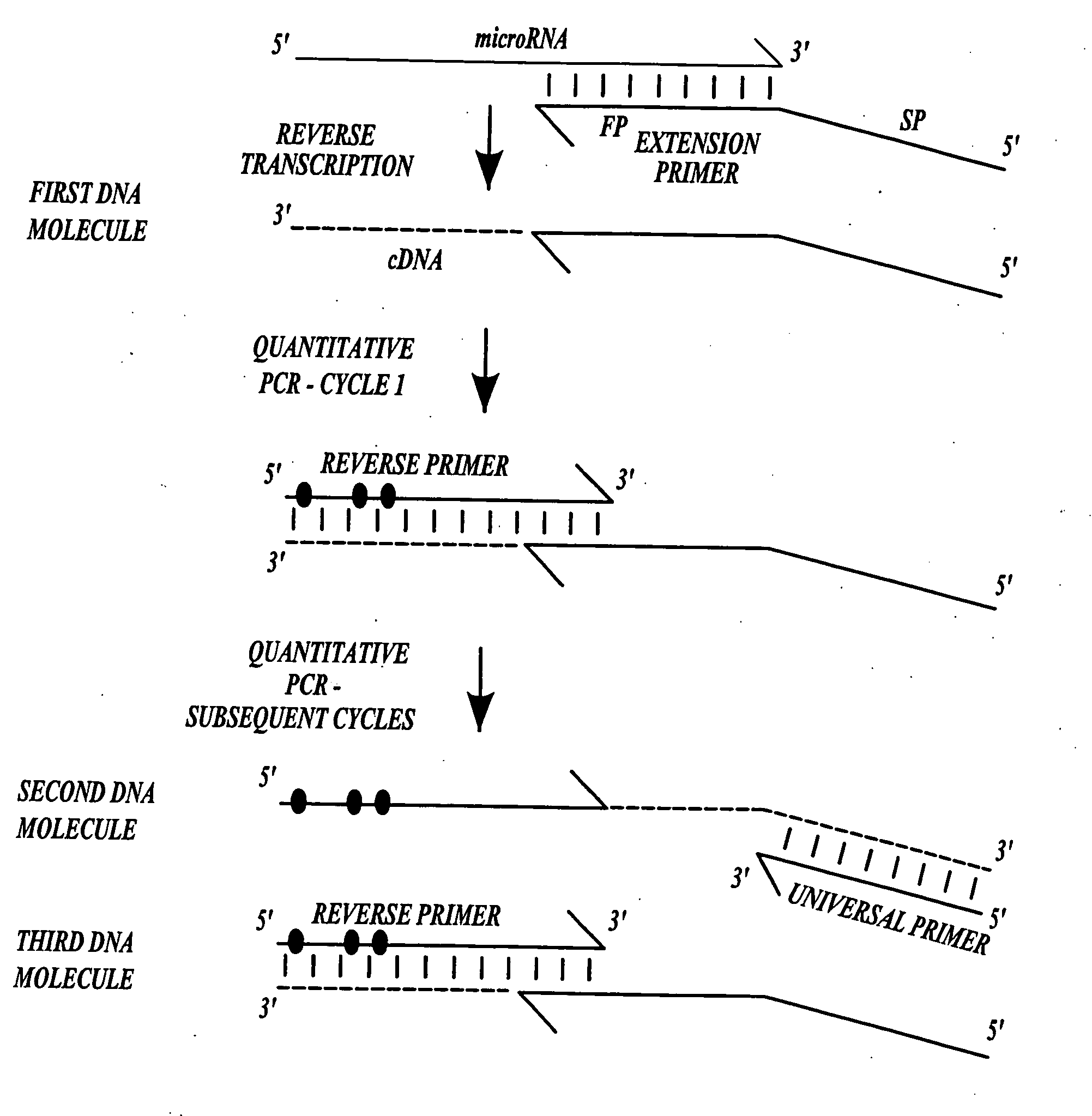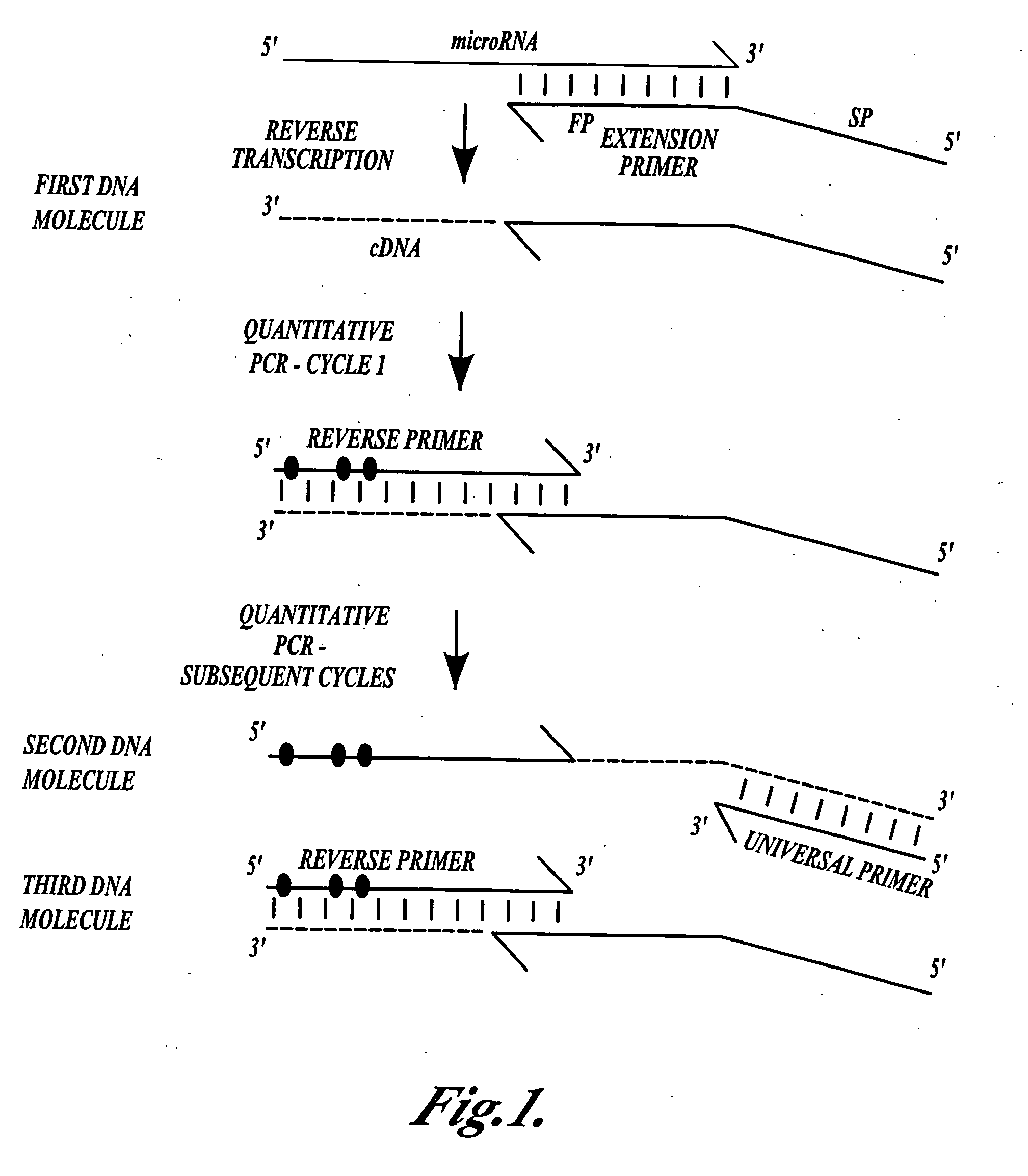Methods for quantitating small RNA molecules
- Summary
- Abstract
- Description
- Claims
- Application Information
AI Technical Summary
Benefits of technology
Problems solved by technology
Method used
Image
Examples
example 1
[0061]This Example describes a representative method of the invention for producing DNA molecules from microRNA target molecules.
[0062]Primer extension was conducted as follows (using InVitrogen SuperScript III® reverse transcriptase and following the guidelines that were provided with the enzyme). The following reaction mixture was prepared on ice:[0063]1 μl of 10 mM dNTPs[0064]1 μl of 2 μM extension primer[0065]1-5 μl of target template[0066]4 μL of “5× cDNA buffer”[0067]1 μl of 0.1 M DTT[0068]1 μl of RNAse OUT[0069]1 μl of SuperScript III® enzyme[0070]water to 20 μl
[0071]The mixture was incubated at 50° C. for 30 minutes, then 85° C. for 5 minutes, then cooled to room temperature and diluted 10-fold with TE (10 mM Tris, pH 7.6, 0.1 mM EDTA).
[0072]Real-time PCR was conducted using an ABI 7900 HTS detection system (Applied Biosystems, Foster City, Calif., U.S.A.) by monitoring SYBR® green fluorescence of double-stranded PCR amplicons as a function of PCR cycle number. A typical 10 ...
example 2
[0081]This Example describes the evaluation of the minimum sequence requirements for efficient primer-extension mediated cDNA synthesis using a series of extension primers for microRNA assays having gene specific regions that range in length from 12 to 3 base pairs.
[0082]Primer Extension Reactions: Primer extension was conducted using the target molecules miR-195 and miR-215 as follows. The target templates miR-195 and miR-215 were diluted to 1 nM RNA (100,000 copies / cell) in TE zero plus 100 ng / μl total yeast RNA. A no template control (NTC) was prepared with TE zero plus 100 ng / μl total yeast RNA.
[0083]The reverse transcriptase reactions were carried out as follows (using InVitrogen SuperScript III® reverse transcriptase and following the guidelines that were provided with the enzyme) using a series of extension primers for miR-195 (SEQ ID NO: 25-34) and a series of extension primers for miR-215 (SEQ ID NO: 35-44) the sequences of which are shown below in TABLE 2.
[0084]The followi...
example 3
[0116]This Example describes assays and primer sets designed for quantitative analysis of human microRNA expression patterns.
[0117]Primer Design:
[0118]microRNA target templates: the sequence of the target templates as described herein are publicly available accessible on the World Wide Web at the Welcome Trust Sanger Institute website in the “miRBase sequence database” as described in Griffith-Jones et al. (2004), Nucleic Acids Research 32:D109-D111 and Griffith-Jones et al. (2006) Nucleic Acids Research 34: D140-D144.
[0119]Extension primers: gene specific primers for primer extension of a microRNA to form a cDNA followed by quantitative PCR (qPCR) amplification were designed to (1) convert the RNA template into cDNA; (2) to introduce a “universal” PCR binding site (SEQ ID NO:1) to one end of the cDNA molecule; and (3) to extend the length of the cDNA to facilitate subsequent monitoring by qPCR.
[0120]Reverse primers: unmodified reverse primers and locked nucleic acid (LNA) containin...
PUM
| Property | Measurement | Unit |
|---|---|---|
| Mass | aaaaa | aaaaa |
| Mass | aaaaa | aaaaa |
| Mass | aaaaa | aaaaa |
Abstract
Description
Claims
Application Information
 Login to View More
Login to View More - R&D
- Intellectual Property
- Life Sciences
- Materials
- Tech Scout
- Unparalleled Data Quality
- Higher Quality Content
- 60% Fewer Hallucinations
Browse by: Latest US Patents, China's latest patents, Technical Efficacy Thesaurus, Application Domain, Technology Topic, Popular Technical Reports.
© 2025 PatSnap. All rights reserved.Legal|Privacy policy|Modern Slavery Act Transparency Statement|Sitemap|About US| Contact US: help@patsnap.com



